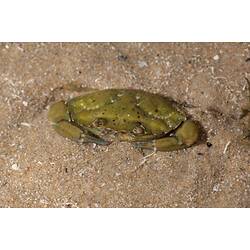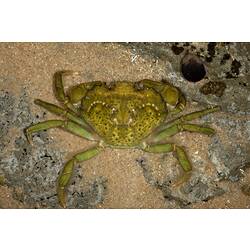General Description
Body mottled dark and pale green-brown, wider than long. Five triangular spines on the side of the carapace (upper shell) behind each eye. The ends of the fourth walking legs are slightly flattened with sharp-angled tips. Up to 10 cm wide (carapace).
Biology
European Shore Crabs were first recorded in Port Phillip in 1900, introduced there accidentally as a hitch-hiker on ships from the UK or Europe. They have since spread throughout coastal Victoria, eastern South Australia and northern Tasmania. The crab is very aggressive, with strong pincers (chelipeds). It competes with and feeds on native species and may be a threat to these species. To prevent the spread of this invasive crab, recreational anglers must not use European Green Shore Crabs as live bait or return live unused crabs to the water.
Distribution
Worldwide. Isolated populations along southern Australian coast. In Victoria, European green shore crabs have been found in Gippsland, Port Phillip and west to Apollo Bay.
Habitat
Most areas, including rocky reef, seagrass and sand flats, to a depth of 60 m.
More Information
-
Animal Type
-
Animal SubType
-
Brief Id
Green-brown bodied crab with five points on front edge of carapace.
-
Colours
Brown, Green
-
Maximum Size
10 cm
-
Habitats
-
Diet
Carnivore
-
Diet Categories
Animal matter, Bivalves, Fish
-
Hazards
Not harmful but a nip from claws could be painful.
-
Endemicity
-
Commercial
No
-
Conservation Statuses
CITES: Not listed, FFG Threatened List: Not listed, EPBC Act 1999: Not listed, IUCN Red List: Not listed
-
Depths
Shore (0-1 m), Shallow (1-30 m), Deep ( > 30 m)
-
Water Column Locations
On or near seafloor
-
Taxon Name
-
Scientific Author
(Linnaeus, 1758)
-
Common Name
European Shore Crab
-
Other Names
Green Shore Crab , European Green Crab , Green Crab
-
Phylum
-
Subphylum
-
Superclass
-
Class
-
Subclass
-
Superorder
-
Order
-
Suborder
-
Infraorder
-
Family
-
Subfamily
-
Genus
-
Species Name
maenas








